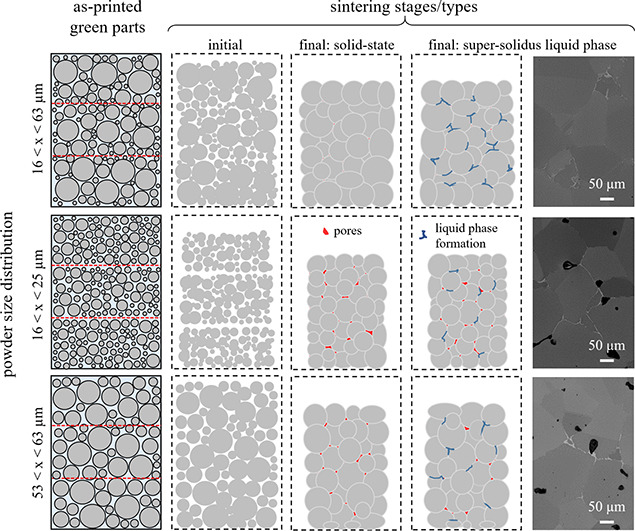In a paper entitled “Effect of powder size distribution on densification and microstructural evolution of binder-jet 3D-printed alloy 625,” a team of researchers test gas-atomized alloy 625 powders of three different powder size distributions including 16–63 μm (full), 16–25 μm (fine) and 53–63 μm (coarse). The powders were 3D printed with green relative bulk densities of about 52%, 45% and 48%, respectively, followed by vacuum-sintering at temperatures between 1225°C and 1300°C for 4 hours.
“For the fine and coarse powders with narrow size distribution, printing defects with high pore coordination numbers may form during the binder jetting process which cannot be removed during the final sintering stage even during supersolidus liquid phase sintering,” the researchers state. “However, the full particle size distribution gave higher green density with fewer large, highly coordinated pores so supersolidus liquid phase sintering was able to reach near-full density. Additionally, the fine powders gave non-uniform, anisotropic linear shrinkage during sintering which is unfavorable for designing complex structures.”
 The researchers, using binder jetting, 3D printed samples of each powder size distribution, and sintered three samples from each set to study densification behavior. The bulk density and mass of each sample was measured when both wet and dry. For all particle size ranges, the relative bulk density increased with increasing sintering temperature from 1225°C to 1285°C. For temperatures above 1270ºC, it was also found that the coarse powder range samples had the lowest sintered density while the fine powder range samples showed the highest density.
The researchers, using binder jetting, 3D printed samples of each powder size distribution, and sintered three samples from each set to study densification behavior. The bulk density and mass of each sample was measured when both wet and dry. For all particle size ranges, the relative bulk density increased with increasing sintering temperature from 1225°C to 1285°C. For temperatures above 1270ºC, it was also found that the coarse powder range samples had the lowest sintered density while the fine powder range samples showed the highest density.
“In general, it is thought that wide pore size distributions and low green density associated packing defects affect microstructural evolution, in particular the grain size and diffusion distances in final stage sintering and this controls final density,” the researchers state. “Thus, it was essential to examine the effect of the PSD on the average microstructural descriptors associated with the densification process. These include the average grain and pore size.”
In the experiments, binder jet 3D printing parameters including layer thickness, binder saturation and drying time were kept constant in order to study the effect of powder size and particle size distribution on the densification behavior. The following conclusions were reached:
“During densification of parts sintered between 1225 °C and 1300 °C for 4 h, the 16–25 μm powder showed higher linear shrinkage compared to the 16–63 μm and 53–63 μm powders. This correlated with lower green density of 45% achieved from the fine powder compared to the 47% and 52% for coarse and full range powders, respectively. Additionally, it was seen that as the sintering temperature increased to 1285 °C or higher, linear shrinkage in z direction was greater than that in the x and y directions, especially in 16–25 μm powder. This is thought to be due to the effect of gravity on particle rearrangement during sintering.”
In addition, densification was faster in the 16–25 μm powder samples up to 1270°C, but at the higher sintering temperature, the 16–63 μm powder samples showed faster densification behavior and more pore elimination during the final stage supersolidus liquid phase sintering.
Authors of the paper include Amir Mostafaei, Pierangeli Rodriguez De Vecchis, Ian Nettleship and Markus Chmielus.
Discuss this and other 3D printing topics at 3DPrintBoard.com or share your thoughts below.
Subscribe to Our Email Newsletter
Stay up-to-date on all the latest news from the 3D printing industry and receive information and offers from third party vendors.
You May Also Like
3D Printing Webinar and Event Roundup: May 5, 2024
We’ve got a busy week of 3D printing events ahead of us, in Texas, Florida, Washington, D.C., Shanghai, and more. Webinar offerings will cover medical models, PolyJet 3D printing, additive...
High Stakes, High Speed: KVG Acquires 15 Nexa3D HSE 3D Printers to Boost Military Tech
As 3D printing increasingly intersects with defense and military logistics, a new partnership between Nexa3D and mission support logistics firm KVG stresses the growing importance of this technology in strategic...
Construction 3D Printing CEO Reflects on Being Female in Construction
Natalie Wadley, CEO of ChangeMaker3D, could hear the words of her daughter sitting next to her resounding in her head. “Mum, MUM, you’ve won!” Wadley had just won the prestigious...
3D Printing News Briefs, February 17, 2024: Shot Blasting, Service Bureaus, & More
In today’s 3D Printing News Briefs, we’re starting out with post-processing, as SKZ Würzburg is using a shot blast system from AM Solutions for its research. Moving on to business,...

































